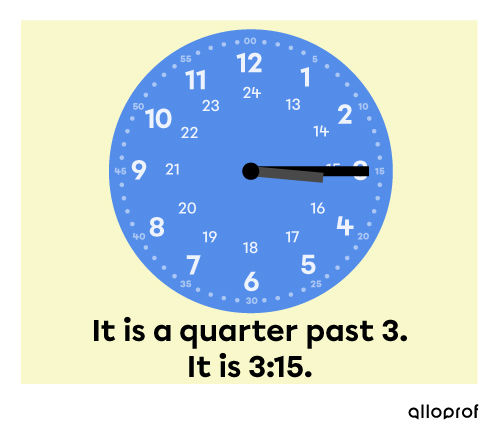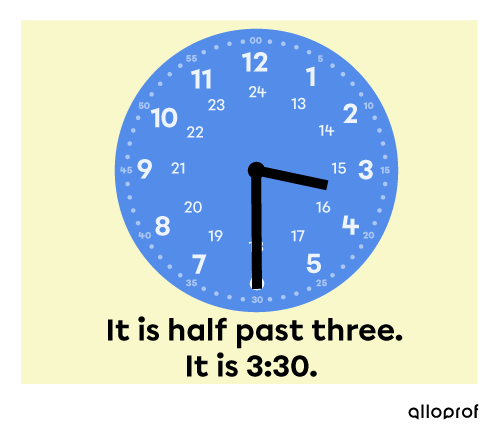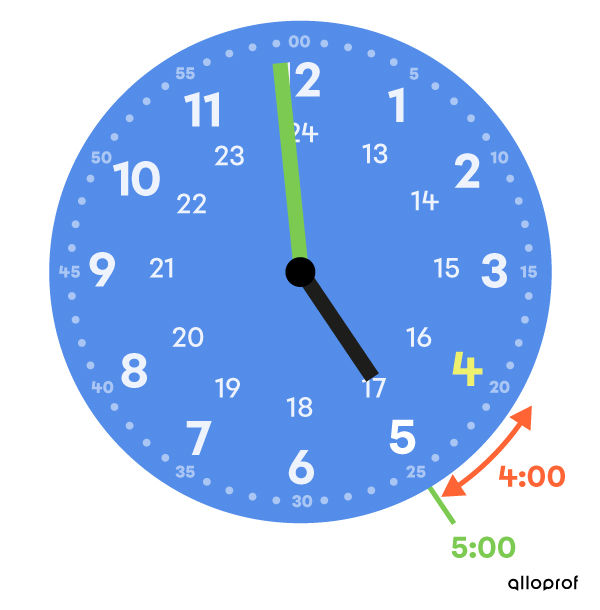To learn how to tell time, it is important to understand the role of the hands and the numbers on a clock. For a reminder, consult The Clock concept sheet.
To tell time, start by looking at the number shown by the little hand.
The hour changes when the little hand reaches the next number.
It is 7 o’clock until the little hand points directly at the 8. If the hand is between 7 and 8, it is still 7 o’clock.

After determining the hour, look at the big hand (the minute hand). This hand points towards a dash or dot that shows the number of minutes that have passed since the start of the hour. Start by counting from the dash or dot found just to the right of the number 12.
The big hand of this clock points to the 20th minute mark of the hour. Therefore, it is 7:20.

When the big hand points to 12, it is exactly the hour indicated by the little hand.
Examples:

When the little hands and the big hands are both on 12, it is either noon or midnight.

The last step is to look at the second hand (the thinnest hand). It points to a dash or a dot that shows how many seconds have passed since the start of the minute.
Some clocks do not have a second hand, so it is not possible to tell the seconds.
The second hand has moved 45 seconds since the start of the minute. It is 7:20 and 45 seconds.

Time can be written in different ways:
-
9 o’clock, 9:00, 9 a.m.or 9 p.m.,
-
midnight, 00:00 or 12 a.m.,
-
noon, 12:00 or 12 p.m.,
-
10:23 or twenty-three minutes past 10.
When the big minute hand has moved 15 minutes, a quarter of an hour (or one out of four parts of an hour) has passed.
Example:

When the big minute hand has moved 30 minutes, a half hour has passed.
Example:

To learn how to tell time, it is important to understand the role of the hands and the numbers on a clock. For a reminder, consult The Clock concept sheet.
While the big hand is moving around the clock, the little hand slowly moves closer to the next number. The hour changes when the big minute hand has fully moved around all the dots or dashes on the clock (60 minutes).
In these examples, the further the big minute hand moves, the closer the little hand approaches to 8:00.

When the big minute hand has almost finished its rotation around the clock, the little hour hand is very close to the number that indicates the next hour.
Example:
Looking at the small hand in this image, we may think that it is 5:00.

Nevertheless, the minute hand has not fully completed its rotation around the clock. There is 1 minute left.

To know the hour, you must look at the previous number. It is 4:59.

I have to follow these steps to tell time on a clock.
-
I look at the number indicated by the little hand to know the hour.
-
I look at the big hand to see how many minutes have passed since the start of the hour.
What time is it on the following clock if it is the morning?

|
 |
|
 |
It is 10:24.